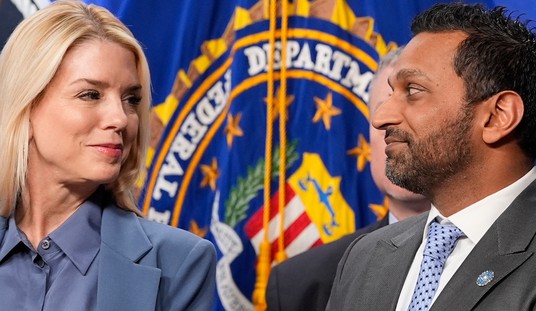Chief Justice John Roberts giveth, and Chief Justice John Roberts taketh away. The Supreme Court delivered its final two opinions of this term, both authored by Roberts, which turned into a split for Joe Biden overall. In a surprise, the court freed Biden from the injunction that forced him to enforce the Trump-era Remain in Mexico party, deciding Biden v Texas on a 5-4 split that also brought Justice Brett Kavanaugh along as the (arguably) deciding vote.
First and likely more importantly in terms of policy, Roberts led a 6-3 decision in West Virginia v EPA that has significant repercussions for agency jurisdiction. The court ruled that the EPA could not use the Clean Air Act to regulate carbon emissions without a more specific grant of that authority from Congress, although Roberts kept the decision as narrow as he could:
The Supreme Court on Thursday limited the Environmental Protection Agency’s ability to regulate carbon emissions from power plants, dealing a blow to the Biden administration’s efforts to address climate change.
The vote was 6 to 3, with the court’s three liberal justices in dissent, saying that the majority had stripped the E.P.A. of “the power to respond to the most pressing environmental challenge of our time.”
The ruling appeared to curtail the agency’s ability to regulate the energy sector, limiting it to measures like emission controls at individual power plants and, unless Congress acts, ruling out more ambitious approaches like a cap-and-trade system at a time when experts are issuing increasingly dire warnings about the quickening pace of global warming.
The implications of the ruling could extend well beyond environmental policy and further signal that the court’s newly expanded conservative majority is deeply skeptical of the power of administrative agencies to address major issues facing the nation and the planet.
The New York Times notes that this draws a pretty clear line in the sand from this court about agency jurisdiction and authority. It also parallels the CDC eviction-moratoria case, they note, in which the court rebuked the CDC for overstepping its jurisdiction and authority, granted by Congress in its enabling statute. If Congress wanted to expand that authority, then Congress should have acted, Roberts ruled at that time.
Roberts writes today that not only did Congress not specifically authorize the EPA to regulate carbon emissions in the manner they planned in their Clean Power Plan, Congress explicitly rejected such proposals:
The dissent also cites our decision in American Elec. Power Co. v. Connecticut, 564 U. S. 410 (2011). Post, at 20. The question there, however, was whether Congress wanted district court judges to decide, under unwritten federal nuisance law, “whether and how to regulate carbon- dioxide emissions from power plants.” 564 U. S., at 426. We answered no, given the existence of Section 111(d). But we said nothing about the ways in which Congress intended EPA to exercise its power under that provision. And it is doubtful we had in mind that it would claim the authority to require a large shift from coal to natural gas, wind, and solar. After all, EPA had never regulated in that manner, despite having issued many prior rules governing power plants under Section 111. See, e.g., 71 Fed. Reg. 9866 (2006); 70 Fed. Reg. 28616; 44 Fed. Reg. 33580; 36 Fed. Reg. 24875 (1973).
Finally, we cannot ignore that the regulatory writ EPA newly uncovered conveniently enabled it to enact a program that, long after the dangers posed by greenhouse gas emissions “had become well known, Congress considered and rejected” multiple times. Brown & Williamson, 529 U. S., at 144; see also Alabama Assn., 594 U. S., at ___ (slip op., at 2); Bunte Brothers, 312 U. S., at 352 (lack of authority not previously exercised “reinforced by [agency’s] unsuccessful attempt . . . to secure from Congress an express grant of [the challenged] authority”). At bottom, the Clean Power Plan essentially adopted a cap-and-trade scheme, or set of state cap-and-trade schemes, for carbon. See 80 Fed. Reg. 64734 (“Emissions trading is . . . an integral part of our BSER analysis.”). Congress, however, has consistently rejected proposals to amend the Clean Air Act to create such a program. See, e.g., American Clean Energy and Security Act of 2009, H. R. 2454, 111th Cong., 1st Sess.; Clean Energy Jobs and American Power Act, S. 1733, 111th Cong., 1st Sess. (2009). It has also declined to enact similar measures, such as a carbon tax. See, e.g., Climate Protection Act of 2013, S. 332, 113th Cong., 1st Sess.; Save our Climate Act of 2011, H. R. 3242, 112th Cong., 1st Sess. “The importance of the issue,” along with the fact that the same basic scheme EPA adopted “has been the subject of an earnest and profound debate across the country, . . . makes the oblique form of the claimed delegation all the more suspect.” Gonzales, 546 U. S., at 267–268 (internal quotation marks omitted).
In this case, it wasn’t just the regulation that crossed the line, but also its arbitrary nature. The EPA attempted to impose caps that didn’t have any relation to the statute nor to a rational and objective standard, Roberts wrote:
First, unlike Section 111, the Acid Rain and NAAQS programs contemplate trading systems as a means of complying with an already established emissions limit, set either directly by Congress (as with Acid Rain, see 42 U. S. C. §7651c) or by reference to the safe concentration of the pollutant in the ambient air (as with the NAAQS). In Section 111, by contrast, it is EPA’s job to come up with the cap itself: the “numerical limit on emissions” that States must apply to each source. 80 Fed. Reg. 64768. We doubt that Congress directed the Agency to set an emissions cap at the level “which reflects the degree of emission limitation achievable through the application of [a cap-and-trade] system,” §7411(a)(1), for that degree is indeterminate. It is one thing for Congress to authorize regulated sources to use trading to comply with a preset cap, or a cap that must be based on some scientific, objective criterion, such as the NAAQS. It is quite another to simply authorize EPA to set the cap itself wherever the Agency sees fit.
Finally, Roberts concludes that any such policy with the magnitudes of impacts that this scheme has needs a specific and explicit act of Congress to authorize. This is the “major question” doctrine at work:
Capping carbon dioxide emissions at a level that will force a nationwide transition away from the use of coal to generate electricity may be a sensible “solution to the crisis of the day.” New York v. United States, 505 U. S. 144, 187 (1992). But it is not plausible that Congress gave EPA the authority to adopt on its own such a regulatory scheme in Section 111(d). A decision of such magnitude and consequence rests with Congress itself, or an agency acting pursuant to a clear delegation from that representative body. The judgment of the Court of Appeals for the District of Columbia Circuit is reversed, and the cases are remanded for further proceedings consistent with this opinion.
Justice Neil Gorsuch goes farther in rebuking the dissent. First, his concurrence offers a lengthy review and support for the major-questions doctrine as a means to rein in the increasingly expansive bureaucratic state, which he notes presents a threat to constitutional order and self-governance anyway. The doctrine is born of necessity to ensure that unelected officials remain responsive to both Congress and the president, and also that they do not intrude on matters that properly belong to the sovereign states.
This matter in particular calls for that kind of scrutiny, Gorsuch writes:
Asking these questions again yields a clear answer in our case. See ante, at 28–31. As the Court details, the agency before us cites no specific statutory authority allowing it to transform the Nation’s electrical power supply. See ante, at 28. Instead, the agency relies on a rarely invoked statutory provision that was passed with little debate and has been characterized as an “obscure, never-used section of the law.” Ante, at 6 (internal quotation marks omitted). Nor has the agency previously interpreted the relevant provision to confer on it such vast authority; there is no original, longstanding, and consistent interpretation meriting judicial respect. See ante, at 20–22. Finally, there is a “mismatch” between the EPA’s expertise over environmental matters and the agency’s claim that “Congress implicitly tasked it, and it alone, with balancing the many vital considerations of national policy implicated in deciding how Americans will get their energy.” Ante, at 25. Such a claimed power “requires technical and policy expertise not traditionally needed in [the] EPA’s regulatory development.” Ibid. (internal quotation marks omitted). Again, in observing this much, the Court does not purport to pass on the wisdom of the agency’s course. It acknowledges only that agency officials have sought to resolve a major policy question without clear legislative authorization to do so.
In places, the dissent seems to suggest that we should not be unduly “‘concerned’” with the Constitution’s assignment of the legislative power to Congress. Post, at 29 (opinion of KAGAN, J.). Echoing Woodrow Wilson, the dissent seems to think “a modern Nation” cannot afford such sentiments. Post, at 29–31. But recently, our dissenting colleagues acknowledged that the Constitution assigns “all legislative Powers” to Congress and “bar[s their] further delegation.” Gundy, 588 U. S., at ___ (plurality opinion of KAGAN, J.) (slip op., at 4) (internal quotation marks and alteration omitted). To be sure, in that case we disagreed about the exact nature of the “nondelegation inquiry” courts must employ to vindicate the Constitution. Id., at ___ (slip op., at 5). But like Chief Justice Marshall, we all recognized that the Constitution does impose some limits on the delegation of legislative power. See ibid.; Wayman, 10 Wheat., at 42– 43. And while we all agree that administrative agencies have important roles to play in a modern nation, surely none of us wishes to abandon our Republic’s promise that the people and their representatives should have a meaningful say in the laws that govern them. Cf. Rucho v. Common Cause, 588 U. S. ___, ___ (2019) (KAGAN, J., dissenting) (slip op., at 7) (“Republican liberty demands not only, that all power should be derived from the people; but that those entrusted with it should be kept in dependence on the people” (internal quotation marks and alteration omitted)).
Finally, Gorsuch writes, inaction by Congress is no excuse for agencies to violate the authority it grants. Gorsuch rebukes the Barack Obama claim of “I’ve got a pen, and I’ve got a phone” to such authority without explicitly naming Obama:
When Congress seems slow to solve problems, it may be only natural that those in the Executive Branch might seek to take matters into their own hands. But the Constitution does not authorize agencies to use pen-and-phone regulations as substitutes for laws passed by the people’s representatives. In our Republic, “[i]t is the peculiar province of the legislature to prescribe general rules for the government of society.” Fletcher v. Peck, 6 Cranch 87, 136 (1810). Because today’s decision helps safeguard that foundational constitutional promise, I am pleased to concur.
Well said. If the court firms this approach up with further precedents, it will force Congress to legislate responsibly and allow for accountability for those policies and their outcomes … which is what Congress uses agencies to prevent, of course.
The decision in Biden v Texas is more technical in nature, relating to the sequence of policy changes at the White House. Roberts writes that the lower court erroneously treated a second order rescinding the Remain in Mexico as a “post hoc rationalization” rather than as a remedied new effort that replaced a flawed first effort. From the summary:
Turning to the merits, section 1225(b)(2)(C) provides: “In the case of an alien . . . who is arriving on land . . . from a foreign territory contiguous to the United States, the [Secretary] may return the alien to that territory pending a proceeding under section 1229a.” Section 1225(b)(2)(C) plainly confers a discretionary authority to return aliens to Mexico. This Court has “repeatedly observed” that “the word ‘may’ clearly connotes discretion.” Opati v. Republic of Sudan, 590 U. S. ___, ___.
Respondents and the Court of Appeals concede that point, but urge an inference from the statutory structure: because section 1225(b)(2)(A) makes detention mandatory, they argue, the otherwise discretionary return authority in section 1225(b)(2)(C) becomes mandatory when the Secretary violates that mandate. The problem is that the statute does not say anything like that. The statute says “may.” If Congress had intended section 1225(b)(2)(C) to operate as a mandatory cure of any noncompliance with the Government’s detention obligations, it would not have conveyed that intention through an unspoken inference in conflict with the unambiguous, express term “may.” The contiguous-territory return authority in section 1225(b)(2)(C) is discretionary—and remains discretionary notwithstanding any violation of section 1225(b)(2)(A).
The historical context in which section 1225(b)(2)(C) was adopted confirms the plain import of its text. Section 1225(b)(2)(C) was added to the statute more than 90 years after the “shall be detained” language that appears in section 1225(b)(2)(A). And the provision was enacted in response to a BIA decision that had questioned the legality of the contiguous-territory return practice. Moreover, since its enactment, every Presidential administration has interpreted section 1225(b)(2)(C) as purely discretionary, notwithstanding the consistent shortfall of funds to comply with section 1225(b)(2)(A).
In other words, the Biden administration has the discretion whether to use Trump’s Remain in Mexico policy or not. The second order, which provided more detail on the policy change, sufficed under the Administrative Procedure Act, Roberts ruled, along with Kavanaugh and the three liberal justices.
Justice Samuel Alito, writing for the dissenters, argues otherwise. Texas and Missouri also objected to the form of the second order, and Alito said the court should have taken more time with this case to explore all of the issues. Instead, the majority accommodated the Biden administration to rush the case to a faulty conclusion:
Faced with this situation, the Court was correctly concerned about deciding the reach of §1252(f )(1) and the important APA question without any briefing. The Court could have—and, in my judgment, should have—dealt with this problem by deciding this case without saying anything about §1252(f )(1) other than that it bars injunctive relief. Instead, with the end of the Term looming ahead, the Court directed the parties to brief these issues, but it gave them just one week to do so. And as the Court should have anticipated, those briefs raised new questions that it would have been useful to explore at argument had that been held. But determined to accommodate the Government’s request that this case be decided this Term, the majority inadvisably plows ahead.
I would not do so. Because of the Government’s request for a speedy decision, we established an expedited schedule for the filing of merits briefs and squeezed in oral argument on the next-to-last argument date. We would have been in a position to give thorough consideration to the §1252(f )(1) issue if it had been addressed in the parties’ regular briefs, but having relegated the issue to a terse footnote in its brief, and having been unprepared to discuss the issue at argument, the Government is not entitled to any further special treatment. We should simply vacate the decision below and remand for reconsideration in light of our decision in Gonzalez.3 Nothing more is either necessary or appropriate under the circumstances.
At any rate, Biden and his team now have a carte blanche to end the Remain in Mexico policy. Will they use it? They already are bungling the border crisis that they touched off by promising to end it and to relax asylum rules and penalties. The court rulings gave Biden an easy out in helping him contain the damage, but now he has to choose between his progressive wing and rational policies that will keep the situation from getting even worse than it already is. Based on Biden’s track record, expect him to cave to his progressive wing.
It’s quite an interesting end to this term, in which conservatives won a lot more than they lost. The question will be, of course, whether conservatives can make those gains work for them in terms of better policy. We won’t know those answers until after the midterms, and then again after the 2024 election.








Join the conversation as a VIP Member